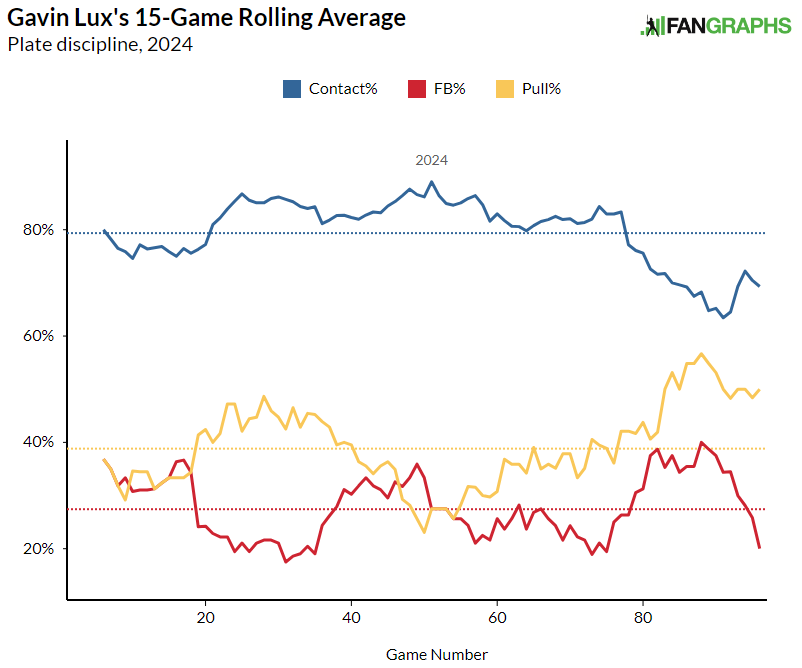It’s the middle of August and that means the end of the fantasy baseball season is coming into view, especially if you’re playing in a weekly matchup league where playoffs will likely be starting in the next couple of weeks. The season may be winding down, but staying vigilant in your quest to improve your team — especially as some of your league mates have lost interest or turned their sights to football drafts — can make all the difference for who brings home the championship trophy. Let’s take a look at three of baseball’s hottest players to see if you can count on their recent strong results to continue down the stretch.
Gavin Lux, 2B, Los Angeles Dodgers
As a former elite prospect, Lux carried massive expectations as he entered the big leagues. He originally debuted back in 2019, but injuries and disappointing results have kept the young second baseman from truly latching on and securing a full-time lineup slot, but that may finally be changing. Since the All-Star break, Lux has looked like a new hitter. His slash line was .213/.267/.295 entering the Mid-Summer Classic and has exploded to .381/.452/.635 afterward. Lux’s .459 wOBA and 202 wRC+ in the second half are top-10 marks.
One of the first things to ask when analyzing a giant change in performance is batted ball luck, and boy has Lux been enjoying quite a bit of it. He has a career .313 BABIP over 1,353 plate appearances and in the second half, he has a ludicrous .512 BABIP. That’s the second-highest mark of any hitter. That alone raises a gigantic red flag over Lux’s results. No matter if he’s made legitimate changes or not, no batter can sustainably run a BABIP that high.
Digging under the hood more, one of our newest stats here at Pitcher List, Process+ paints a rosier picture.
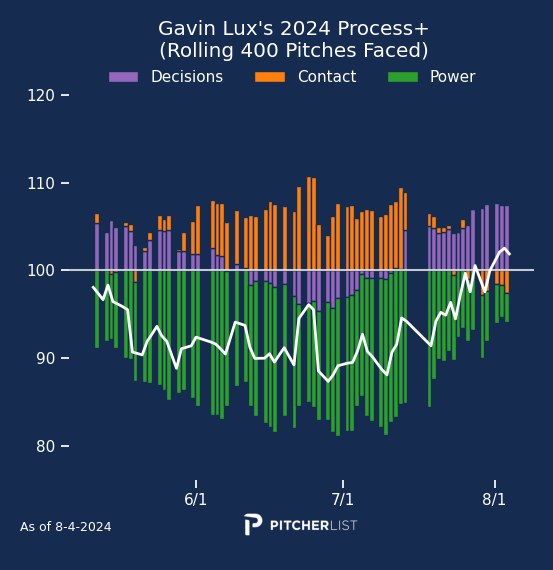
That small gap you see on the right side of the chart is the All-Star break, and we can very clearly see that his results after have started ticking up. He’s making improved swing decisions while doing a better job of getting to his power, although his contact ability has taken a hit over the last few weeks. It seems like Lux has been selling out more to find his power stroke. His strikeout rate has jumped from 20.6% in the first half to 27.4% in the second half. While his overall swing rates haven’t changed, he’s making less contact but pulling balls in the air more often.
Perhaps Lux’s biggest strength as a player is his eye at the plate. Even in his disappointing seasons, he’s posted well above-average chase and walk rates. That should give him a nice cushion to fall back on from an OBP perspective, meaning that even if his strikeout rate stays in the upper 20s with this new approach, he can probably continue to make it work as long as his walk rate can stay near his 9.5% career average.
Despite the strong second-half results and drop in contact rate, Lux actually hasn’t been hitting the ball any harder than usual.
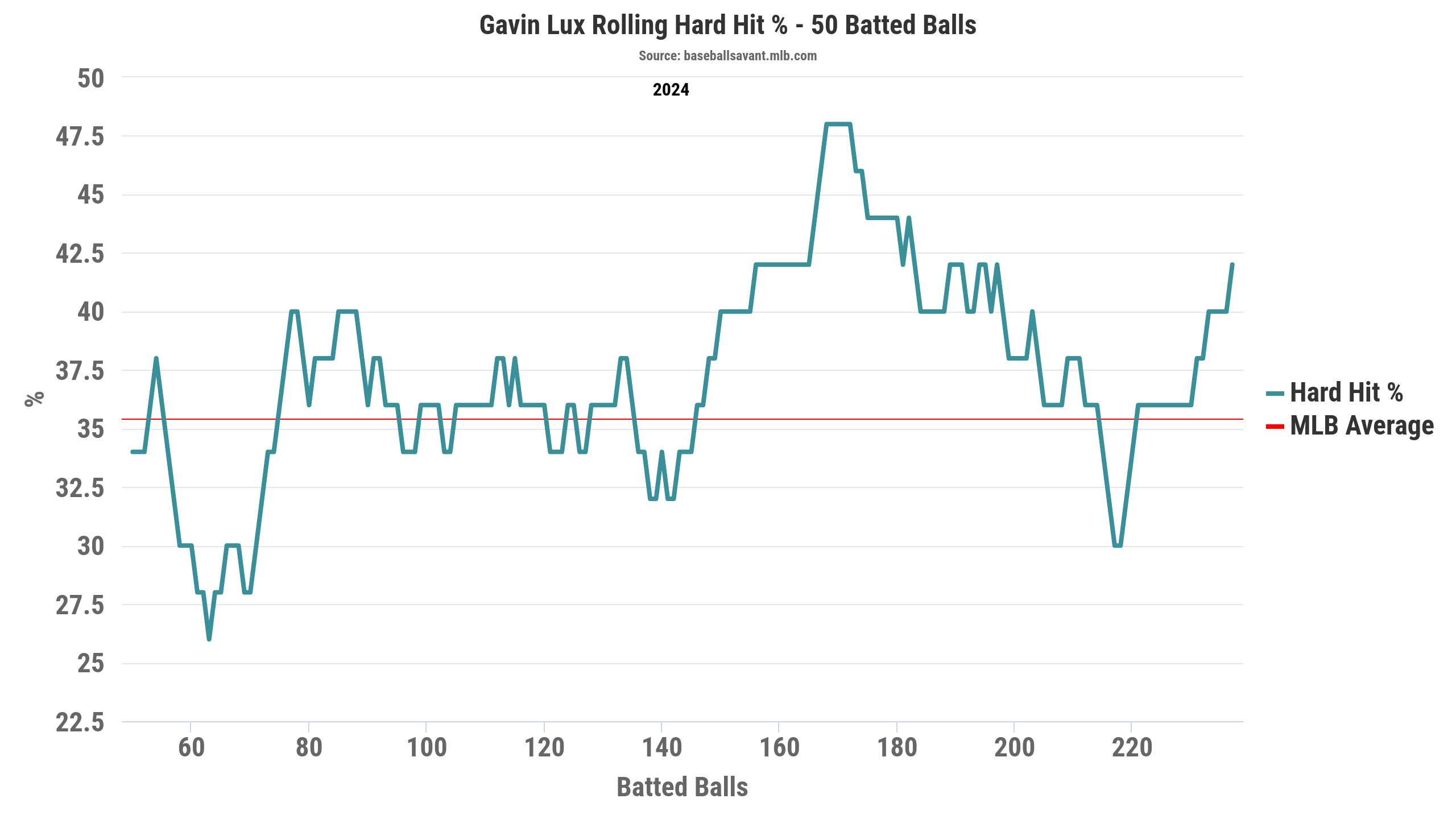
Lux has never been a player who’s made loud contact. His 37.6% hard-hit rate is just 33rd percentile and his 4.6% barrel rate is even lower sitting in the 20th percentile, and that hasn’t necessarily changed much recently. One thing that has changed in his batted ball profile is his Launch Angle Sweet-Spot rate. He’s been doing a much better job of making contact in the most desirable launch angle window (8-32 degrees). That’s led to a modest increase in line-drive rate which is encouraging to see, but we’ve seen him go on similar stretches at previous points in his career, so I’m not entirely sold that what we’re seeing from a batted-ball metric standpoint is going to stick.
Verdict: Not Legit. I badly want to buy into Lux as an exciting breakout candidate, but I don’t see enough in his profile to think what he’s done over the last month will continue long-term. That said, it is hard to analyze these in-season changes to a player’s profile, especially with a sample size spanning not even a month. For fantasy purposes, Lux is still an intriguing addition if you need middle infield help. Dave Roberts has rewarded Lux’s strong play with a big lineup bump. He’s gone from hitting in the bottom third of the order to the heart of the lineup over the last 10 days. At the very least, you can ride out this hot streak and reap the fantasy rewards, just don’t be afraid to drop Lux if he strings together a couple of bad weeks.
Tyler Fitzgerald, SS/OF, San Francisco Giants
A road trip up the California coast from Lux in Los Angeles gets us to San Francisco where the Giants may have found their next franchise shortstop. Ok, it may be a little quick to crown Fitzgerald as a surefire thing, but the early returns from the former fourth-round pick are phenomenal. Since taking over as the full-time starting shortstop on July 20th, Fitzgerald is hitting a cool .349/.411/.791 with 10 home runs, 21 runs, 17 RBI, and five stolen bases. His .498 wOBA and 230 wRC+ are both fourth-best in the sport over that period.
We’re dealing with a smaller sample size here, but once again turning to Process+ paints a great overall look at Fitzgerald as a hitter.
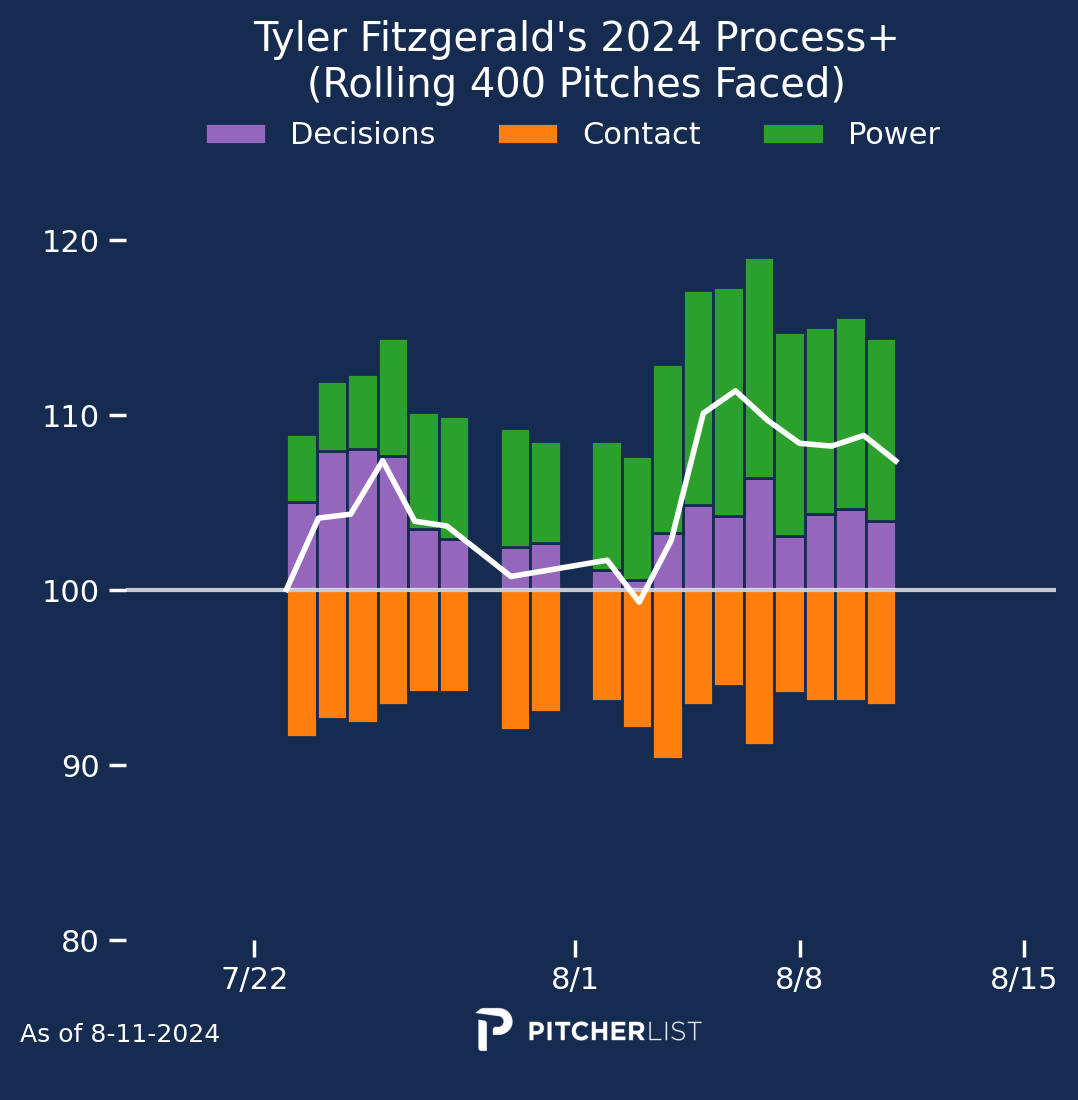
Bad contact results are what immediately jump out here and it really weighs down his otherwise strong decision and power results. That checks out looking at individual metrics as well. Fitzgerald’s 70.4% contact rate is 22nd percentile, and even worse, his 77.2% contact rate on pitches inside the strike zone is in the lowly 9th percentile. That’s not what you want to see.
Despite the weak contact numbers, Fitzgerald has some of the best-expected statistics in the game. He doesn’t have enough plate appearances to qualify for leaderboards, but if he did, he’d be in the 80th+ percentile in xwOBA, xBA, and xSLG, even though the way he’s getting to those numbers is unconventional.
With strong xStats you generally see a lot of hard contact, but that’s not the case here. Although Fitzgerald’s 11.5% barrel rate is 83rd percentile, his 36.8% hard-hit%, 88.4 mph Avg. EV, and 107.3 mph Max EV are below league average. What Fitzgerald does do well though is hit the ball at ideal launch angles while maximizing the balls he hits in the air. Fitzgerald’s 45.6% Launch Angle Sweet-Spot% is one of the top marks in the game and factors heavily in his 92nd percentile line drive rate. With mediocre power indicators, you wouldn’t expect Fitzgerald to have hit as many home runs as he has, but when he hits a fly ball, he does damage. His 89.7 mph FB EV is 72nd percentile, and it’s the only one of his exit velocity metrics that clocks in above league average.
One of Fitzgerald’s greatest assets is his speed. His 30.1 mph sprint speed is one of the highest rates in the league, and when you combine that with an elite line drive rate, you typically get better-than-expected results on balls in play. That’s exactly what we’re seeing with Fitzgerald’s .392 BABIP. It’s much too high — the highest mark among qualified hitters is Aaron Judge’s .379 mark — so it will come down sharply. The MLB average BABIP is .291, but if we give Fitzgerald a generous boost from his speed and batted ball results, we’re likely looking at it settling in near the .320-.325 range. The rest of the season projections from ZiPS, ATC, and THE BAT give Fitzgerald a .234-.241 average the rest of the way, which seems reasonable if not on the low end.
Turning away from batted ball results, let’s take a look at how Fitzgerald does when he doesn’t put the ball in play. Unfortunately, it’s not encouraging. He’s striking out 28.2% of the time, and there’s little reason to expect a major improvement. Fitzgerald ran 30+% strikeout rates just a few years ago in 400+ and 500+ plate appearances samples at the High-A and Double-A levels, although those numbers did start to fall to the mid-20% range when he reached Triple-A. Fitzgerald doesn’t necessarily make poor swing decisions, though. He’s not overly aggressive and he does a good job of recognizing pitches to offer at, he just can’t seem to make contact with them regularly.
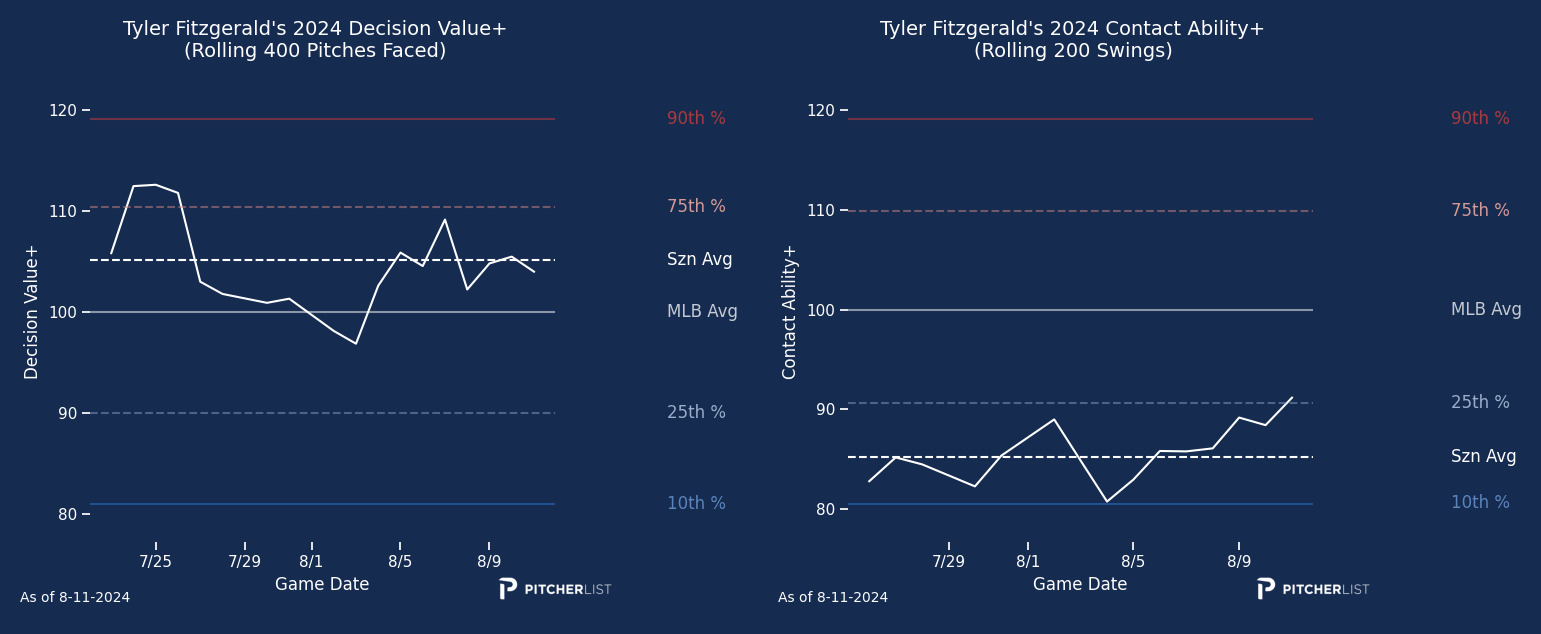
That odd set of results is perfectly encapsulated by Fitzgerald’s strong 86th-percentile chase rate and poor 22nd-percentile whiff rate. With FanGraphs’ Prospects Report giving him just a 30/35 Hit tool (on a 20/80 scale), this stands to be the biggest area that Fitzgerald needs to grow in to become a long-term MLB regular.
Verdict: Not Legit. Fitzgerald’s results have been spectacular but the process he’s had to get there is a mixed bag. The strong barrel and line drive rates are encouraging, but they come with below-average hard-hit rates. His speed makes him a weapon on the basepaths, but with an unsustainably high BABIP and bad strikeout rate, when the batted ball luck falters, I’m unsure he’ll be able to reach base reliably to use that speed. There’s certainly a path here for Fitzgerald to make this analysis look silly, and I hope he does, but for right now, this looks much more like a hot streak than him becoming a legitimate fantasy difference-maker. In dynasty and keeper leagues, Fitzgerald is a great option to stash. He’s only had 215 big-league plate appearances, so there’s plenty of room for him to adjust and find a way to continue posting these strong results.
Spencer Schwellenbach, SP, Atlanta Braves
The back of Atlanta’s starting rotation has been a revolving door ever since Spencer Strider suffered a torn UCL just nine innings into the season, but his first-name brother Spencer Schwellenbach has stepped into the impossibly big shoes rather admirably. In his first taste of MLB action, Schwellenbach has gone 4-5 with a 3.95 ERA, 1.06 WHIP, and 77 strikeouts in 70.2 innings pitched. His 22.6% K-BB% is the 11th-best mark among starting pitchers who have tossed at least 70 frames this year.
While those overall numbers are rather impressive from the 24-year-old right-hander, his recent performance is what’s really been turning heads. Over Schwellenbach’s last four outings, he’s posted a 3.12 ERA, 3.14 FIP, and 0.88 WHIP, but here’s the best part: 36 strikeouts to just 2 walks! You could pretty easily mistake those numbers as coming from Atlanta’s other Spencer. Sure, Schwellenbach’s recent run may not have come against a gauntlet of offensive juggernauts (STL, @NYM, MIA, @COL), but it’s been impressive enough to make his fantasy roster rates soar, so let’s take a look under the hood.
Schwellenbach has a wide arsenal featuring six different pitch types. His four-seam fastball and slider are his most used weapons making up nearly half of his total offerings, and for good reason — both pitches have above-average stuff as seen by pitch modeling systems. Our own PLV model grades the four-seamer in the 64th percentile while the slider comes in even more impressively at the 85th percentile. Stuff+ and Pitching Bot also like the pitches, with Schwellenbach’s four-seamer earning a 109 Stuff+ (100 is average) and a 57 from Pitching Bot (20/80 scale). Meanwhile, like with PLV, the slider shines even brighter with grades of 112 and 61, respectively. Here’s a look at Schwellenbach’s entire arsenal.
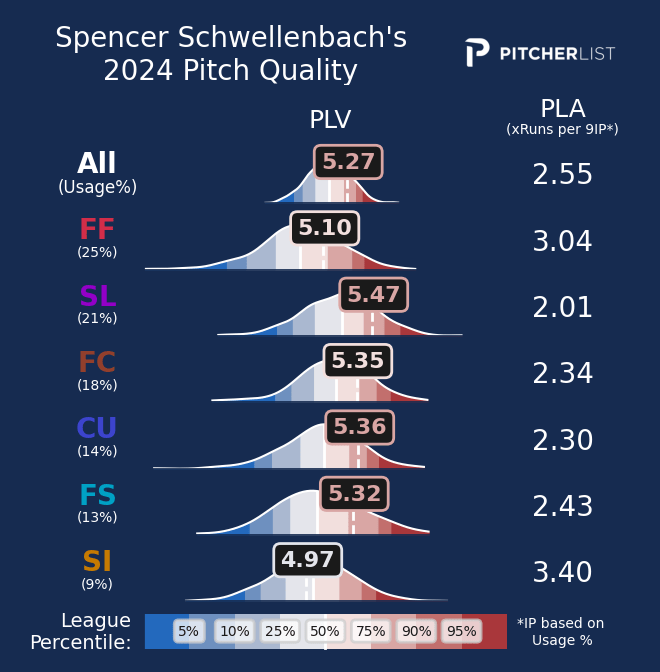
I love seeing that many weapons, especially from a young arm. Not many young pitchers have the confidence in that many offerings to keep hitters from being able to sit on one or two of their best pitches. That level of variability, whether the pitches are top-tier or not, is a weapon all by itself, but for Schwellenbach, pretty much all of his pitches grade out positively. Only his sinker comes in with a below-league-average PLV grade.
Not only is Schwellenbach packing six different punches, but each of his weapons has a very distinct movement profile, further enhancing each one.
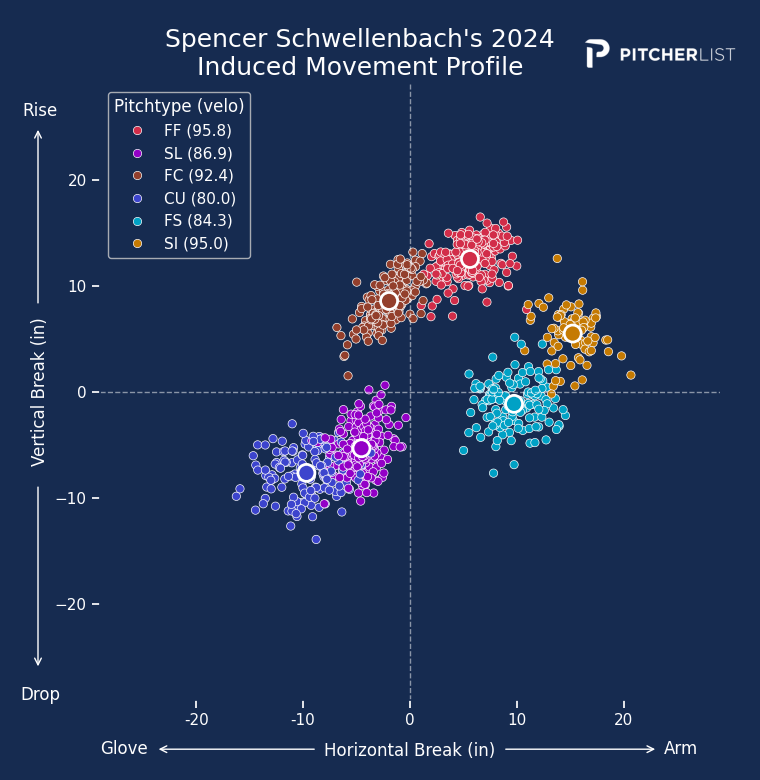
It’s not just pitch models that like Schwellenbach’s arsenal. They all have good results too. Four of his six pitches have a CSW% in the 69th percentile or better with just the slider and sinker being slightly below average. When batters do make contact, they don’t often do much with Schwellebach’s pitches. His five most-used offerings all have an above-average ICR, with the sinker again missing the cut.
Perhaps my favorite thing to see in Schwellenbach’s profile is that he can reliably turn to most of his pitches when he’s in a jam and needs a strike. His four most-used pitches — four-seamer, slider, cutter, and curveball — all have strike rates that fall in the 80th percentile or better. That allows Schwellenbach to limit baserunners and avoid big innings. Just four of the nine home runs that Schwellenbach has allowed have been hit with runners on base, and only one of those homers came with multiple runners on.
One of the most popular ways to analyze a pitcher has become fastball shape analysis, and although his four-seam fastball shape doesn’t leap off the page, it’s still good enough to not be the cause of too much concern given his wealth of legitimate secondary pitches.
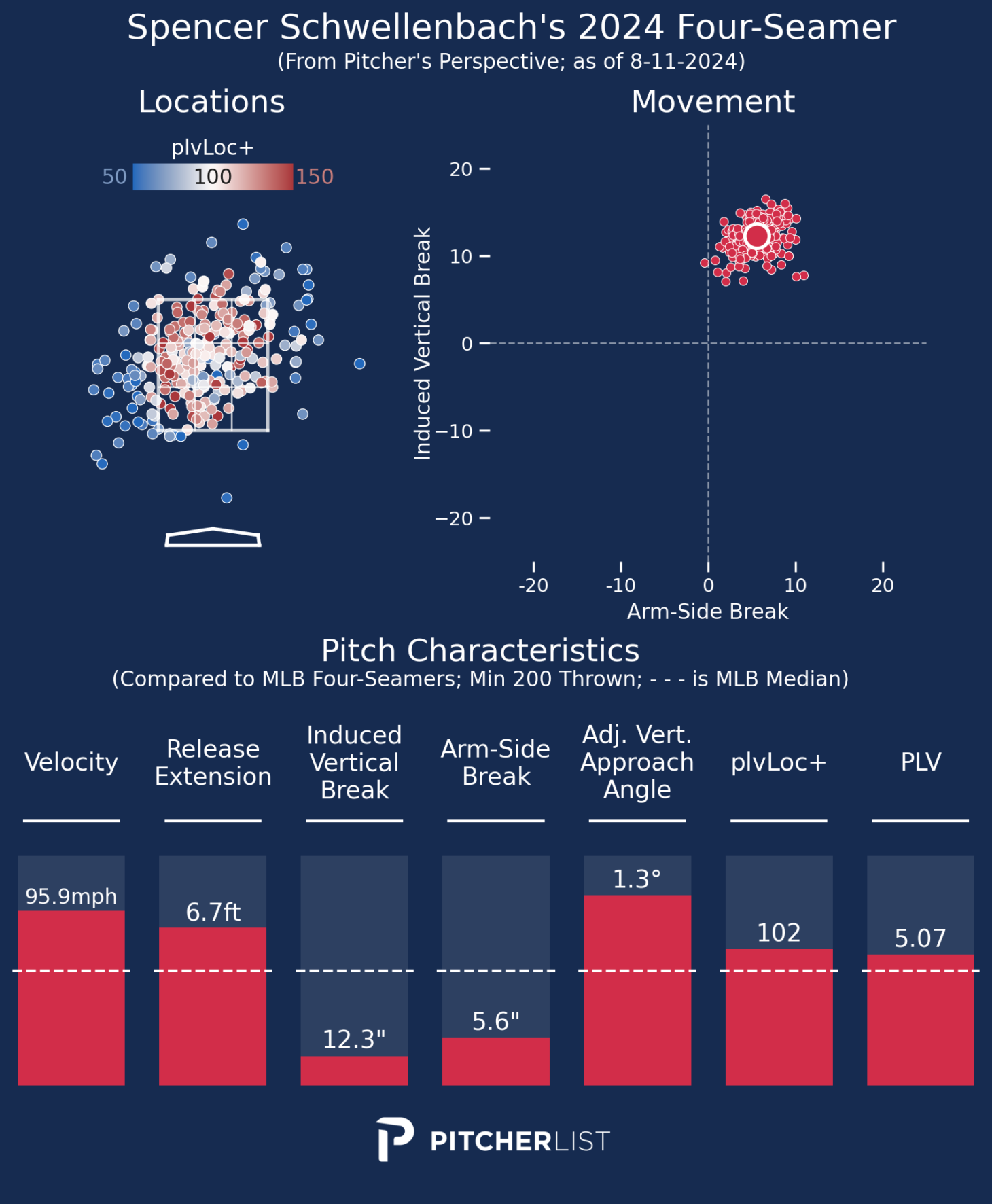
Verdict: Legit. Schwellenbach has everything in his arsenal that he needs to be an impact pitcher down the stretch, and if his recent performance is any indication, it’s going to be a whole lot of fun to have him on your roster over the season’s final weeks. He has a good primary fastball, multiple trust-worthy secondaries, the ability to throw strikes reliably, and is on a team that should give him plenty of win opportunities. Schwellenbach probably isn’t on your waiver wire anymore, but if he is, pick him up right now.
Featured image by Doug Carlin (@Bdougals on Twitter)

